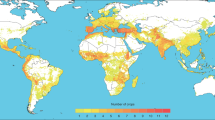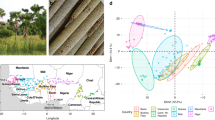Abstract
Crop diversity underpins food security and adaptation to climate change. Concerted conservation efforts are needed to maintain and make this diversity available to plant scientists, breeders and farmers. Here we present the story of the rescue and reconstitution of the unique seed collection held in the international genebank of International Center for Agricultural Research in the Dry Areas (ICARDA) in Syria. Being among the first depositors to the Svalbard Global Seed Vault, ICARDA managed to safety duplicate more than 80% of its collection before the last staff had to leave the genebank in 2014 because of the war. Based on the safety duplicates, ICARDA since 2015 have rebuilt their collections and resumed distribution of seeds to users internationally from their new premises in Morocco and Lebanon. We describe the multifaceted and layered structure of the global system for the conservation and use of crop diversity that enabled this successful outcome. Genebanks do not work alone but in an increasingly strengthened and experienced multilateral system of governance, science, financial support and collaboration. This system underpins efforts to build sustainable and socially equitable agri-food systems.
This is a preview of subscription content, access via your institution
Access options
Access Nature and 54 other Nature Portfolio journals
Get Nature+, our best-value online-access subscription
$29.99 / 30 days
cancel any time
Subscribe to this journal
Receive 12 digital issues and online access to articles
$119.00 per year
only $9.92 per issue
Buy this article
- Purchase on Springer Link
- Instant access to full article PDF
Prices may be subject to local taxes which are calculated during checkout


Similar content being viewed by others
References
Frankel, O. & Bennett, E. Genetic Resources in Plants: Their Exploration and Conservation (Blackwell Scientific Publications, 1970).
Hufford, M. B., Berny Mier y Teran, J. C. & Gepts, P. Crop biodiversity: an unfinished magnum opus of nature. Annu. Rev. Plant Biol. 70, 727–751 (2019).
Fowler, C. & Hodgkin, T. Plant genetic resources for food and agriculture: Assessing global availability. Annu. Rev. Environ. Resour. 29, 143–179 (2004).
Godfray, H. C. J. et al. Food security: the challenge of feeding 9 billion people. Science 327, 812–818 (2010).
Willett, W. et al. Food in the Anthropocene: the EAT–Lancet Commission on healthy diets from sustainable food systems. The Lancet 393, 447–492 (2019).
Crosby, A. W. Ecological Imperialism: the Biological Expansion of Europe, 900–1900 (Cambridge Univ. Press, 2004).
Diamond, J. & Bellwood, P. Farmers and their languages: the first expansions. Science 300, 597–603 (2003).
Harlan, J. R. Crops and Man (American Society of Agronomy, 1975).
Larson, G. et al. Current perspectives and the future of domestication studies. Proc. Natl Acad. Sci. USA 111, 6139–6146 (2014).
Zohary, D. & Hopf, M. Domestication of Plants in the Old World: the Origin and Spread of Cultivated Plants in West Asia, Europe and the Nile Valley (Oxford Univ. Press, 2000).
Harlan, J. R. Our vanishing genetic resources. Science 188, 617–621 (1975).
Aichi biodiversity targets. Convention on Biological Diversity https://www.cbd.int/sp/targets/ (2010).
International Treaty on Plant Genetic Resources for Food and Agriculture. FAO http://www.planttreaty.org/ (2001).
The Sustainable Development Goals. United Nations https://www.un.org/sustainabledevelopment/ (2015).
Amri, A. ICARDA’S Genebank Resources and Activities: A Vital Tool in Ensuring a Food-Secure Future for Dryland Communities (ICARDA, 2015).
Khoury, C. K. et al. Origins of food crops connect countries worldwide. Proc. R. Soc. B 283, 20160792 (2016).
Mbow, C. et al. in Climate Change and Land: an IPCC Special Report on Climate Change, Desertification, Land Degradation, Sustainable Land Management, Food Security and Greenhouse Gas Fluxes in Terrestrial Ecosystems Ch. 5 (IPCC, 2019).
Porter, J. R. et al. in Climate Change 2014: Impacts, Adaptation, and Vulnerability (Field, C. B. et al.) 485–533 (Cambridge Univ. Press, 2014).
Kelley, C. P., Mohtadi, S., Cane, M. A., Seager, R. & Kushnir, Y. Climate change in the Fertile Crescent and implications of the recent Syrian drought. Proc. Natl Acad. Sci. USA 112, 3241–3246 (2015).
Werrell, C. E., Femia, F. & Sternberg, T. Did we see it coming?: State fragility, climate vulnerability, and the uprisings in Syria and Egypt. SAIS Rev. Int. Aff. 35, 29–46 (2015).
Gilmore, E. A., Risi, L. H., Tennant, E. & Buhaug, H. Bridging research and policy on climate change and conflict. Curr. Clim. Change Rep. 4, 313–319 (2018).
De Châtel, F. The role of drought and climate change in the Syrian uprising: untangling the triggers of the revolution. Middle East. Stud. 50, 521–535 (2014).
Brück, T. & d’Errico, M. Food security and violent conflict: introduction to the special issue. World Dev. 117, 167–171 (2019).
FAO, IFAD, UNICEF, WFP & WHO. The State of Food Security and Nutrition in the World 2017. Building Resilience for Peace and Food Security (FAO Rome, 2017).
Kanfash, M. & Al-Jasem, A. Syrians are Watching Their Crops Burn. These Crimes of Starvation Must End. The Guardian https://bit.ly/311Te3e (2019).
Sengupta, S. How a Seed Bank, Almost Lost in Syria’s war, Could Help Feed a Warming Planet. The New York Times https://nyti.ms/2SS8gE0 (2017).
ICARDA receives gregor mendel innovation prize for ensuring safekeeping of its genebank collection. ICARDA https://bit.ly/370RVFj (2015).
Alexanyan, S. M. & Krivchenko, V. I. Vavilov Institute scientists heroically preserve world plant genetic resources collections during World War II siege of Leningrad. Diversity 7, 10–13 (1991).
Tracking Progress on Food and Agriculture-related SDG Indicators (FAO, 2020); http://www.fao.org/sdg-progress-report/en/#sdg-2
The State of the World’s Biodiversity for Food and Agriculture (eds J. Bélanger, J. & D. Pilling, D.) (FAO Commission on Genetic Resources for Food and Agriculture Assessments, 2019).
International Treaty on Plant Genetic Resources for Food and Agriculture. FAO http://www.fao.org/plant-treaty/countries/en (2020).
Esquinas-Alcázar, J. T., Frison, C. & López, F. in Plant Genetic Resources and Food Security (eds Frison, C. et al.) 35–58 (Routledge, 2012).
Andersen, R. in Routledge Handbook of Agricultural Biodiversity (eds Hunter, D. et al.) 449–470 (Routledge, 2017).
Toledo, Á. & Manzella, D. The Role of the International Treaty on Plant Genetic Resources for Food and Agriculture (FAO, 2012).
GRIN-Global: a data management tool for all genebanks. Crop Trust https://www.croptrust.org/blog/grin-global-a-data-management-tool-for-all-genebanks/ (2020).
Seed portal of the Svalbard global seed vault. NordGen https://www.nordgen.org/sgsv (2020).
CGIAR Genebank Platform 2018 Annual Report (Genebank Platform, 2019).
Noriega, I. L. et al. CGIAR Operations under the Plant Treaty Framework. Crop Sci. 59, 819–832 (2019).
The Second Report on the State of the World’s Plant Genetic Resources (FAO, 2010).
Genebank Standards for Plant Genetic Resources for Food and Agriculture (FAO, 2014).
CGIAR. Crop Trust CGIAR Genebank Platform https://www.genebanks.org/ (2020).
van Hintum, T., Menting, F. & van Strien, E. Quality indicators for passport data in ex situ genebanks. Plant Genet. Resour. 9, 478–485 (2011).
Wepage of the global crop diversity trust. Crop Trust https://www.croptrust.org/ (2020).
Bari, A. et al. Focused identification of germplasm strategy (FIGS) detects wheat stem rust resistance linked to environmental variables. Genet. Resour. Crop Ev. 59, 1465–1481 (2012).
Westengen, O. T., Jeppson, S. & Guarino, L. Global ex-situ crop diversity conservation and the Svalbard global seed vault: assessing the current status. PLoS ONE 8, e64146 (2013).
Standard Agreement between the Depositor and the Norwegian Ministry of Agriculture and Food (MAF, 2020).
Qvenild, M. Svalbard Global Seed Vault: a ‘Noah’s Ark’ for the world’s seeds. Dev. Pract. 18, 110–116 (2008).
Lagi, M., Bertrand, K. Z. & Bar-Yam, Y. The food crises and political instability in North Africa and the Middle East. SSRN https://doi.org/10.2139/ssrn.1910031 (2011).
Acknowledgements
We thank M. Major and L. Marshall for preparing the artwork. Work for this Perspective performed by O.T.W. was supported by the Research Council of Norway (grant no. RCN-274519), in the research project Suitable Seeds for Food Security in Fragile States, led by the Fridtjof Nansen Institute, Norway. We also thank project colleagues R. Andersen, K. Rosendal, P. W. Skedsmo, K. Adhikari and A. Ramana for their comments on the manuscript.
Author information
Authors and Affiliations
Contributions
O.T.W. and C.L. conceived and wrote the manuscript. M.Y., A.A. and Å.A. contributed to the manuscript.
Corresponding author
Ethics declarations
Competing interests
The authors declare no competing interests.
Additional information
Peer review information Nature Plants thanks John Dickie and Peter Raven for their contribution to the peer review of this work.
Publisher’s note Springer Nature remains neutral with regard to jurisdictional claims in published maps and institutional affiliations.
Rights and permissions
About this article
Cite this article
Westengen, O.T., Lusty, C., Yazbek, M. et al. Safeguarding a global seed heritage from Syria to Svalbard. Nat. Plants 6, 1311–1317 (2020). https://doi.org/10.1038/s41477-020-00802-z
Received:
Accepted:
Published:
Issue Date:
DOI: https://doi.org/10.1038/s41477-020-00802-z
This article is cited by
-
No resurrection without preservation
Nature Plants (2023)



